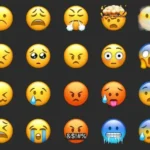
Social media, a phenomenon that has reshaped the way we connect, communicate, and share information, has a rich history filled with milestones and transformative moments. From the early days of Friendster to the global dominance of Facebook, and the rise of platforms like TikTok, social media has evolved into an integral part of our daily lives. In this exploration, we delve into 25 historical facts and numerical trivia about social media, offering insights into its growth, influence, and impact on society over the years.
Birth of Social Media: The concept of social media emerged in the early 2000s as a response to the growing need for digital platforms that facilitated social connections and online interactions. Platforms like Friendster, MySpace, and LinkedIn laid the foundation for this new era of communication. They allowed users to create profiles, connect with friends and colleagues, and share information, marking the beginning of a fundamental shift in how people interacted in the digital age.
Facebook’s Founding: On February 4, 2004, Mark Zuckerberg and his college roommates launched Facebook, initially as a platform exclusive to Harvard University students. Its rapid expansion to other Ivy League universities and eventually worldwide marked the beginning of a social media giant. Facebook’s transformation from a dorm-room project to a global phenomenon exemplifies the power of technology and innovation in reshaping communication and social dynamics.
Facebook’s Growth: In less than a year after its launch, Facebook reached the significant milestone of 1 million users. This exponential growth demonstrated the platform’s universal appeal and its capacity to connect people across geographical boundaries, setting the stage for its future dominance in the social media landscape.
Twitter’s Launch: Twitter, introduced on March 21, 2006, by Jack Dorsey and his team, brought a new dimension to social media with its microblogging format. The 140-character limit per tweet encouraged succinct, real-time updates, fostering a culture of rapid information sharing and engagement. Twitter’s influence on news dissemination, social commentary, and political discourse has been profound.
140 Characters: Twitter’s initial character limit of 140 characters was a deliberate design choice, meant to fit within the constraints of SMS text messages. It challenged users to be concise and creative in their communication. In 2017, Twitter doubled the character limit to 280, accommodating more extensive discussions while retaining its unique format.
YouTube’s Debut: YouTube, founded in February 2005 by Chad Hurley, Steve Chen, and Jawed Karim, forever changed how people consume and share video content. The platform allowed anyone to upload, view, and share videos, democratizing online video creation and sparking the rise of content creators, influencers, and online video as a dominant medium.
Acquisition by Google: Google’s acquisition of YouTube in November 2006 for $1.65 billion was a watershed moment for both companies. It solidified YouTube’s position as the leading video-sharing platform and provided Google with a powerful platform for video advertising and content distribution.
Instagram’s Start: Instagram, launched on October 6, 2010, by Kevin Systrom and Mike Krieger, revolutionized photo-sharing on social media. Its emphasis on visual storytelling through images and later videos appealed to a broad audience. Instagram’s success exemplified the growing importance of visual content in social media engagement.
Facebook’s Global Dominance: By 2021, Facebook had amassed more than 2.8 billion monthly active users, making it the largest social media platform in the world. This massive user base cements its influence on global communication, information dissemination, and advertising. Facebook’s reach extends to nearly every corner of the globe, transcending cultural and linguistic barriers.
WhatsApp Acquisition: In February 2014, Facebook acquired WhatsApp, a messaging app known for its end-to-end encryption and user privacy, for a staggering $19 billion. This acquisition signaled Facebook’s recognition of the importance of mobile messaging in the evolving landscape of social media and communication. WhatsApp’s role in connecting people globally, regardless of geographical boundaries, aligns with the broader trends in social media’s impact on global connectivity.
Snapchat’s Founding: Founded in September 2011 by Evan Spiegel, Bobby Murphy, and Reggie Brown, Snapchat introduced a unique approach to social media with its ephemeral messaging. The platform allowed users to send photos and videos that disappeared after being viewed, emphasizing privacy and spontaneity. Snapchat’s format and features, including filters and Stories, contributed to its popularity among younger users.
Filter Feature: Snapchat introduced the “Stories” feature in October 2013, which allowed users to compile photos and videos into a narrative that disappeared after 24 hours. This feature not only added a new dimension to storytelling on social media but also influenced other platforms, including Instagram and Facebook, to adopt similar features.
LinkedIn’s IPO: In May 2011, LinkedIn became the first major social media platform to go public with its initial public offering (IPO). The successful IPO marked a significant moment for professional networking online and demonstrated the financial viability of social media companies in the stock market.
Emoji Usage: As of 2021, there are over 3,000 emojis in use worldwide. Emojis have become an integral part of online communication, transcending language barriers and adding emotional depth to messages. The evolution and expansion of the emoji lexicon reflect the importance of visual expression in modern communication.
Influencer Marketing: By 2020, the influencer marketing industry had grown to an estimated worth of over $9 billion. Influencer marketing involves collaborating with individuals who have a significant social media following to promote products and services. It has become a powerful advertising strategy, reshaping how brands connect with consumers.
Social Media Addiction: According to a 2020 survey, people spend an average of 2 hours and 24 minutes per day on social media. The addictive nature of social media platforms, driven by features like infinite scrolling and notifications, has raised concerns about the impact of excessive screen time on mental health and productivity.
Twitter’s First Tweet: Jack Dorsey’s first tweet, “just setting up my twttr,” was sent on March 21, 2006. This inaugural tweet has since become iconic, highlighting Twitter’s simplicity and real-time nature.
Fake News Impact: During the 2016 U.S. presidential election, fake news stories on social media were estimated to have reached over 100 million Americans. The proliferation of misinformation and its potential to influence public opinion underscored the need for improved media literacy and fact-checking efforts.
Social Media Bans: In January 2021, Twitter permanently suspended the account of then-U.S. President Donald Trump, citing concerns about incitement to violence. This move sparked debates about the power of social media companies in moderating content and their role in shaping public discourse.
Hashtag Origin: Twitter introduced the hashtag (#) in 2007 as a way for users to categorize and search for content. It was first proposed by user Chris Messina. The hashtag has since become a ubiquitous symbol across social media platforms and is used for trending topics, social movements, and brand campaigns.
Meme Culture: Memes, humorous or thought-provoking images, videos, or text, have become a global phenomenon on social media. They often go viral, spreading rapidly across platforms. The influence of memes extends beyond humor, as they have been used for political commentary, social critique, and cultural expression. Memes have become an integral part of internet culture, reflecting the dynamic nature of online communication.
TikTok’s Rise: TikTok, launched in September 2016 by the Chinese company ByteDance, gained widespread popularity and reached 2 billion downloads worldwide in 2020. The platform’s short-form video format, creative editing tools, and algorithm-driven content discovery have made it a cultural and entertainment powerhouse, particularly among younger users.
Data Privacy Concerns: Social media platforms have faced controversies related to data privacy. The Cambridge Analytica scandal in 2018 revealed that the personal data of millions of Facebook users had been harvested without consent for political advertising purposes. This event sparked global discussions about online privacy, data protection, and the role of social media companies in safeguarding user information.
Social Media for Activism: Social media has played a pivotal role in organizing and amplifying social and political movements. Examples include the Arab Spring in 2010-2012, where platforms like Twitter and Facebook were used to coordinate protests and share information, and the Black Lives Matter movement, which gained momentum through hashtags and livestreamed events. Social media has provided a platform for marginalized voices and facilitated global solidarity.
COVID-19 Impact: During the COVID-19 pandemic, social media played a crucial role in disseminating information, connecting people, and providing entertainment. As lockdowns and social distancing measures were implemented, people turned to online platforms for news, social interaction, and content consumption. Social media served as a lifeline for many, highlighting its importance in times of crisis and isolation.
5 Frequently Asked Questions about Social Media:
- Is social media addictive?
Absolutely, social media can be addictive. The constant stream of updates, likes, and comments triggers the reward centers in our brain, releasing dopamine, a feel-good chemical. This positive reinforcement loop keeps us coming back for more, even if it means spending excessive time scrolling or neglecting other aspects of life.
Here are some signs of social media addiction:
- Feeling anxious or restless when you can’t check your social media.
- Losing track of time while scrolling.
- Prioritizing social media over sleep, work, or relationships.
- Experiencing withdrawal symptoms like irritability or boredom when you take a break.
If you suspect you or someone you know struggles with social media addiction, there are steps you can take to manage it. Setting time limits, creating screen-free zones, and replacing social media with healthier activities can all be helpful.
- Is social media bad for my mental health?
Social media’s impact on mental health can be complex. While it can provide a sense of connection and community, it can also lead to feelings of inadequacy, envy, and loneliness. Curated feeds showcasing unrealistic portrayals of lives can make us feel like we’re not measuring up. Additionally, cyberbullying and negative comments can take a toll on self-esteem.
Here are some ways to promote positive mental health while using social media:
- Be mindful of who you follow. Focus on accounts that inspire and uplift you, rather than those that make you feel bad about yourself.
- Limit your screen time. Set clear boundaries and stick to them.
- Don’t compare your life to others’ online highlight reels. Remember, social media is often a carefully constructed facade.
- Focus on real-life connections. Prioritize spending time with loved ones in person.
- What are the privacy concerns surrounding social media?
Social media platforms collect a vast amount of data about their users, including browsing habits, location information, and even private messages. This data can be used for targeted advertising, but it also raises concerns about privacy breaches and identity theft. Additionally, the way social media algorithms curate content can create echo chambers, where users are only exposed to information that confirms their existing beliefs.
Here are some tips for protecting your privacy on social media:
- Review your privacy settings regularly. Most platforms allow you to control who can see your information and posts.
- Be mindful of what you share online. Once something is on the internet, it’s nearly impossible to erase completely.
- Use strong passwords and enable two-factor authentication. This adds an extra layer of security to your accounts.
- How can I use social media for good?
Social media can be a powerful tool for positive change. You can use it to:
- Connect with like-minded people and communities. Find groups that share your interests and causes you care about.
- Raise awareness about important issues. Share information and resources with your network.
- Support charities and social causes. Many organizations use social media to promote their work and fundraising efforts.
- Learn new things. There’s a wealth of educational content available on social media platforms.
- Which social media platform is right for me?
The best social media platform for you depends on your individual needs and interests. Here’s a quick breakdown of some popular platforms:
- Facebook: Great for staying connected with friends and family, sharing news and updates.
- Instagram: More focused on visual content, ideal for sharing photos and videos.
- Twitter: Good for real-time updates and discussions, following news and trends.
- LinkedIn: Professional networking platform, useful for job searching and career development.
- YouTube: Primarily for video content, offers entertainment, educational content, and tutorials.
Consider what you hope to achieve by using social media and choose the platform that best aligns with your goals.









